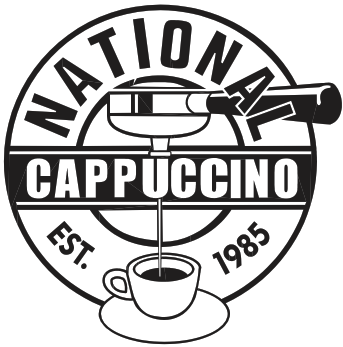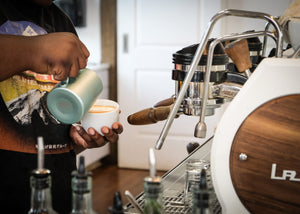Many people are unaware what the job of a barista really involves. Some even think it must be pretty easy. This had me wondering about the role of the barista in a coffee shop in relation to the equipment they use every day. I have heard a few times that all baristas have to do is push a button. The thing is, I’ve worked as a barista and I can assure you it’s much more than that. So, let’s find out what else they could be doing.
A Day in the Life of a Barista
If you’re wondering what’s one of the most important skills a barista has, that’s the power of multitasking (and may I say multi-thinking as well). During their shift, baristas are responsible for a number of tasks such as opening/closing the café, serving customers, cleaning the tables, managing inventory, training new staff, handling complaints, counting cash and more.
As you understand, they do much more than making delicious cups of coffee, so being able to multitask and think ahead is essential. Aside from this, they are required to be very knowledgeable, not only about the coffee beans on offer but also regarding the tools they use every day. The key to a successful coffee shop is the combination of skilled baristas and high quality tools.
The Tools of a Barista
Most don’t realise how many tools baristas use every day to make one cup of coffee. Let’s find out more about them one by one:
- Coffee Machine - the most important companion of a barista - you can’t make hundreds of amazing cups of coffee in a day without a high tech coffee machine.
- Brewers - modern-day coffee shops offer various brewing methods for their filter coffee such as Chemex, V60, Aeropress etc.
- Coffee grinders - most coffee shops have at least two professional coffee grinders, one for espresso and one for filter coffee or to grind customers’ coffee beans to the desired degree.
- Distributor - this tool is used to distribute the coffee grounds in the basket of a portafilter uniformly.
- Tamper - baristas use this to pack coffee grounds evenly into the basket of a portafilter by applying pressure.
- Tamping station - an area where the baristas tamp the coffee.
- Tamping mat - a silicon mat for the tamping station, it helps protect the worktop area and keeps the tamping station neat.
- Portafilter - a tool that features a basket with tamped coffee grounds, it seals on the grouphead of the coffee machine and distributes high pressure of water through the coffee grounds directly into the cup, yielding espresso shots.
- Pitchers - these are for steaming milk, they’re usually stainless steel and feature a spout for better pouring.
- Pitcher rinser - a workstation to keep and rinse the milk pitchers.
- Scalesand timers - these are essential for measuring the right dose of coffee per cup for the right amount of time.
- Knockbox - a box for discarding used coffee grounds, it features a bar, against which the baristas tap the portafitler to throw away the used coffee grounds.
- Cleaning & maintenance supplies - various tools from brushes to spare parts used for cleaning and maintaining the coffee gear.
Let’s Make a Cappuccino
To offer some perspective on how most of these tools are used, I’m going to go through the process of making a cappuccino with you.
- First, I grind the beans fresh directly into my portafilter using the coffee grinder.
- I weigh it to make sure I have the right amount of grams in the basket.
- Next, I place the portafilter on the tamping mat.
- I use the distributor to even the coffee grounds and then tamp gently to create a compact coffee puck.
- I seal the portafilter on the group head of the machine and place the scales right below it.
- Then, I place a cup on the scales and push the coffee machine button to start pulling the espresso shot.
- In the meantime, I grab the milk pitcher, add milk and start steaming to the correct temperature and texture.
- Once the espresso shot is ready, I pour the milk in.
- After the customer gets their cappuccino I clean the steaming wand and the milk pitchers, I discard the used coffee grounds in the knockbox, clean the portafilter and now I’m ready to prepare the next order.
As you realise, all these tools are used hundreds of times every day, this is why it is important they are of good quality. If baristas have tools they can rely on, it makes their shift run smoother and helps them deliver speedy service. Plus they can focus on pulling perfect espresso shots for their customers.
Not Just Pushing a Button
The perfect cup of coffee is always the end goal baristas work towards. Consequently, simply knowing how to use the tools to make the coffee is not enough. Baristas are trained to understand how to adjust certain variables for the best result in the cup. The key here is willingness to practice and passion for what they do. Let’s take the coffee grinder as an example.
You might not know this but in order to switch from one bag of coffee beans to another of different origin, the baristas need to adjust the grind setting so that it suits the new coffee. There are many variables to figure that out, like the dose, the grind size and of course, the flavour. Be sure that baristas sample many bad shots of coffee until they can offer customers the perfect one. So no, it’s not just a case of pushing a button.
Why Cleaning and Maintenance Matters
If you think about it, it should be self-explanatory why cleaning and maintenance of the coffee bar and gear matters. At the end of every shift, baristas need to make sure the bar area is thoroughly cleaned so that it’s ready for the morning shift’s crew. What’s more, some of the gear needs to be washed, plus there is a specific process on how to clean the coffee machine as well.
A clean coffee machine means a good quality cup of coffee. The reason I’m saying all this is because coffee grounds have the tendency to get stuck everywhere and the last thing a barista wants is yesterday’s coffee grounds in today’s cup of coffee. So, baristas need to be trained on how to do this properly and be knowledgeable regarding which cleaning products to use.
As for maintenance, basic knowledge on the most important issues that might come up, can help baristas troubleshoot the problem. When it comes to the coffee machine, there are coffee technician professionals that work closely with the baristas to understand the issue. If baristas have a basic knowledge of what’s wrong, they can help technicians resolve it faster by providing the right information when reporting the issue.
Final Thoughts
All in all, the answer is no, the equipment doesn’t make the barista. It’s how baristas choose to use the equipment provided to them that makes all the difference. However, to be working in a coffee shop that cares about having good quality, high-tech coffee equipment is a privilege for any barista that’s motivated, curious and willing to dive into the amazing world of coffee.

